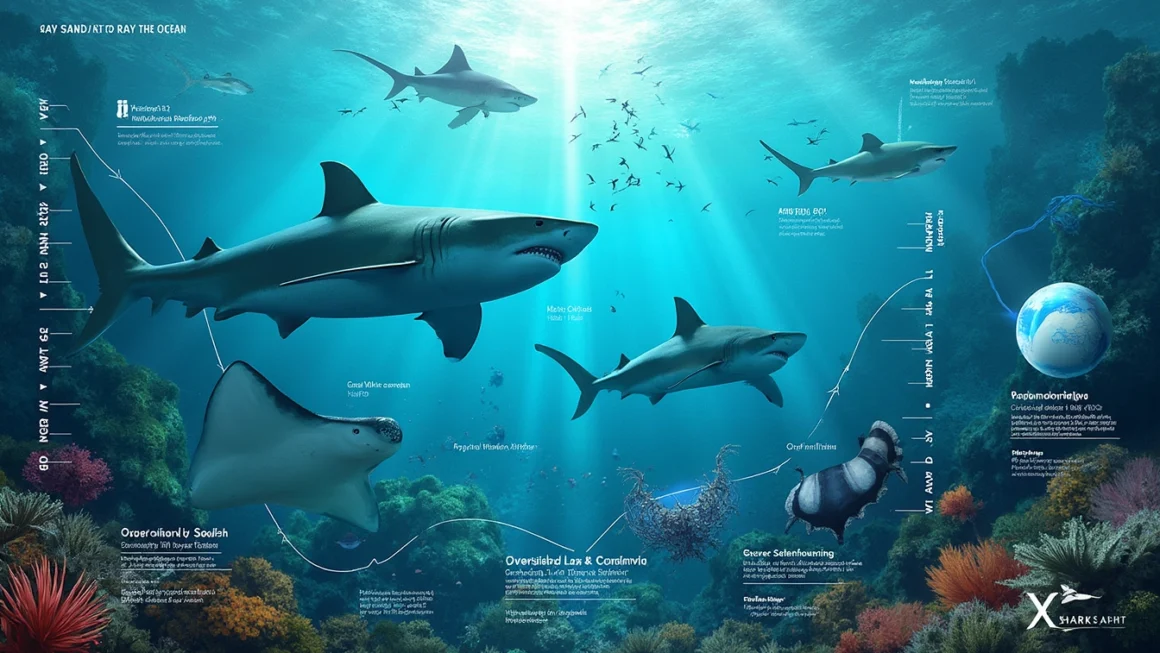The Alarming Decline of Shark and Ray Populations
Table of Contents
In a startling revelation, recent studies have shown that shark and ray populations worldwide have plummeted by an alarming 50% since 1970. This dramatic decline paints a grim picture of the state of our oceans and highlights the urgent need for conservation efforts.
Understanding the Decline
The primary culprit behind this devastating loss is overfishing. As demand for shark fins and meat continues to rise, these magnificent creatures are being hunted at unsustainable rates. Sharks, known for their slow growth and low reproductive rates, are particularly vulnerable to overfishing practices.
Rays, close relatives of sharks, are facing similar threats. Their populations have been severely impacted by both targeted fishing and accidental catches in nets meant for other species.
Impact on Marine Ecosystems
The decline of sharks and rays is not just a problem for these species alone. As apex predators, sharks play a crucial role in maintaining the balance of marine ecosystems. Their disappearance can lead to a cascade of effects throughout the food chain, potentially disrupting entire ocean habitats.
Conservation Efforts and Challenges
While the situation is dire, conservation efforts are underway. Many countries have implemented fishing restrictions and created marine protected areas. However, enforcing these measures remains a significant challenge, especially in international waters.
One innovative approach to conservation involves the use of technology. Automated monitoring systems can help track fishing activities and protect vulnerable marine areas more effectively.
The Role of Consumer Awareness
Consumer awareness plays a crucial role in shark and ray conservation. By making informed choices about seafood consumption and avoiding products derived from these species, individuals can contribute to the protection of these vital marine animals.
Threatened Species and Their Habitats
Among the most threatened species are:
- Great White Sharks
- Hammerhead Sharks
- Manta Rays
- Sawfish
These species are not only iconic but also indicators of ocean health. Their declining numbers serve as a warning sign for the overall state of marine ecosystems.
The Economic Impact
The decline of shark and ray populations doesn’t just affect the environment; it also has significant economic implications. Many coastal communities rely on these species for tourism, particularly through activities like shark diving and wildlife watching. The loss of these species could devastate local economies that depend on marine ecotourism.
Global Conservation Initiatives
Several international organizations are working tirelessly to protect sharks and rays:
- The International Union for Conservation of Nature (IUCN) Shark Specialist Group
- The Shark Trust
- Project AWARE
These organizations focus on research, advocacy, and implementing conservation strategies to protect vulnerable species and their habitats.
Legislative Efforts
On the legislative front, progress is being made. Many countries have banned shark finning, and international trade in some shark species is now regulated under the Convention on International Trade in Endangered Species of Wild Fauna and Flora (CITES).
The Way Forward
To reverse the declining trend in shark and ray populations, a multi-faceted approach is necessary:
- Stricter Fishing Regulations: Implementing and enforcing sustainable fishing practices globally.
- Expanded Marine Protected Areas: Creating more no-take zones where these species can thrive.
- Enhanced Research: Improving our understanding of shark and ray biology and behavior to inform conservation strategies.
- Public Education: Raising awareness about the importance of these species and the threats they face.
- Sustainable Alternatives: Developing and promoting alternatives to shark-derived products.
The Role of Technology in Conservation
Advancements in technology offer new hope for conservation efforts. Satellite tracking, DNA analysis, and artificial intelligence are being employed to monitor populations, track migration patterns, and enforce fishing regulations more effectively.
Conclusion
The halving of shark and ray populations since 1970 is a wake-up call for humanity. It underscores the urgent need for concerted global action to protect these vital species and the marine ecosystems they inhabit. Through a combination of stricter regulations, enhanced conservation efforts, public awareness, and technological innovation, we can hope to reverse this alarming trend.
As stewards of our planet, it’s our responsibility to ensure that future generations can experience the wonder of sharks and rays in our oceans. The time for action is now, before it’s too late for these magnificent creatures that have roamed our seas for millions of years.




